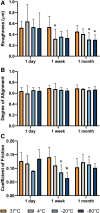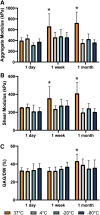Cartilage Assessment Requires a Surface Characterization Protocol: Roughness, Friction, and Function
- PMID: 33678002
- PMCID: PMC8064968
- DOI: 10.1089/ten.TEC.2020.0367
Cartilage Assessment Requires a Surface Characterization Protocol: Roughness, Friction, and Function
Abstract
The surface of articular cartilage is integral to smooth, low-friction joint articulation. However, the majority of cartilage literature rarely includes measurements of surface characteristics and function. This may, in part, be due to a shortage of or unfamiliarity with fast, nondestructive, and, preferably, noncontact methods that can be applied to large cartilage surfaces for evaluating cartilage surface characteristics. A comprehensive methodology for characterizing cartilage surfaces is useful in determining changes in tissue function, as for example, in cases where the quality of cartilage grafts needs to be assessed. With cartilage storage conditions being an area of ongoing and active research, this study used interferometry and tribology methods as efficient and nondestructive ways of evaluating changes in cartilage surface topography, roughness, and coefficient of friction (CoF) resulting from various storage temperatures and durations. Standard, destructive testing for bulk mechanical and biochemical properties, as well as immunohistochemistry, were also performed. For the first time, interferometry was used to show cartilage topographical anisotropy through an anterior-posterior striated pattern in the same direction as joint articulation. Another novel observation enabled by tribology was frictional anisotropy, illustrated by a 53% increase in CoF in the medial-lateral direction compared to the anterior-posterior direction. Of the storage conditions examined, 37°C, 4°C, -20°C, and -80°C for 1 day, 1 week, and 1 month, a 49% decrease in CoF was observed at 1 week in -80°C. Interestingly, prolonged storage at 37°C resulted in up to an 83% increase in the compressive aggregate modulus by 1 month, with a corresponding increase in the glycosaminoglycan (GAG) bulk content. This study illustrates the differential effects of storage conditions on cartilage: freezing tends to target surface properties, while nonfreezing storage impacts the tissue bulk. These data show that a bulk-only analysis of cartilage function is not sufficient or representative. The nondestructive surface characterization assays described here enable improvement in cartilage functionality assessment by considering both surface and bulk cartilage properties; this methodology may thus provide a new angle to explore in future cartilage research and tissue engineering endeavors.
Keywords: anisotropy; articular cartilage; osteochondral allografts; storage; surface characterization; tribology.
Conflict of interest statement
No competing financial interests exist.
Figures







Similar articles
-
Simple geometry tribological study of osteochondral graft implantation in the knee.Proc Inst Mech Eng H. 2018 Mar;232(3):249-256. doi: 10.1177/0954411917751560. Epub 2018 Jan 27. Proc Inst Mech Eng H. 2018. PMID: 29375001 Free PMC article.
-
Evaluation of friction properties of hydrogels based on a biphasic cartilage model.J Mech Behav Biomed Mater. 2013 Dec;28:263-73. doi: 10.1016/j.jmbbm.2013.07.022. Epub 2013 Aug 22. J Mech Behav Biomed Mater. 2013. PMID: 24008138
-
Surface zone articular chondrocytes modulate the bulk and surface mechanical properties of the tissue-engineered cartilage.Tissue Eng Part A. 2014 Dec;20(23-24):3332-41. doi: 10.1089/ten.TEA.2014.0099. Tissue Eng Part A. 2014. PMID: 24947008 Free PMC article.
-
Assessing Cartilage Biomechanical Properties: Techniques for Evaluating the Functional Performance of Cartilage in Health and Disease.Annu Rev Biomed Eng. 2017 Jun 21;19:27-55. doi: 10.1146/annurev-bioeng-071516-044525. Epub 2017 Feb 2. Annu Rev Biomed Eng. 2017. PMID: 28226218 Review.
-
Surface topography as a material parameter.MRS Bull. 2022;47(12):1205-1210. doi: 10.1557/s43577-022-00465-5. Epub 2023 Jan 31. MRS Bull. 2022. PMID: 36846501 Free PMC article. Review.
Cited by
-
Navigating regulatory pathways for translation of biologic cartilage repair products.Sci Transl Med. 2022 Aug 24;14(659):eabp8163. doi: 10.1126/scitranslmed.abp8163. Epub 2022 Aug 24. Sci Transl Med. 2022. PMID: 36001677 Free PMC article. Review.
-
From Molecular to Multiasperity Contacts: How Roughness Bridges the Friction Scale Gap.ACS Nano. 2023 Feb 14;17(3):2205-2211. doi: 10.1021/acsnano.2c08435. Epub 2023 Jan 23. ACS Nano. 2023. PMID: 36690336 Free PMC article.
-
Proof-of-concept study of the TriBot: a robot-based test setup for biotribological analyses of curved articular surfaces.Front Bioeng Biotechnol. 2025 Apr 25;13:1546060. doi: 10.3389/fbioe.2025.1546060. eCollection 2025. Front Bioeng Biotechnol. 2025. PMID: 40352357 Free PMC article.
-
Alterations in articular cartilage frictional properties in the setting of acute gouty arthritis.PLoS One. 2024 Mar 21;19(3):e0298722. doi: 10.1371/journal.pone.0298722. eCollection 2024. PLoS One. 2024. PMID: 38512881 Free PMC article.
-
Optimization of In Situ Indentation Protocol to Map the Mechanical Properties of Articular Cartilage.Materials (Basel). 2022 Sep 16;15(18):6425. doi: 10.3390/ma15186425. Materials (Basel). 2022. PMID: 36143736 Free PMC article.
References
-
- Goodfriend, B., Essilfie, A.A., Jones, I.A., and Thomas Vangsness, C.. Fresh osteochondral grafting in the United States: the current status of tissue banking processing. Cell Tissue Bank 20, 331, 2019 - PubMed
-
- Cook, J.L., Stannard, J.P., Stoker, A.M., et al. . Importance of donor chondrocyte viability for osteochondral allografts. Am J Sports Med 44, 1260, 2016 - PubMed
Publication types
MeSH terms
Substances
LinkOut - more resources
Full Text Sources
Other Literature Sources

